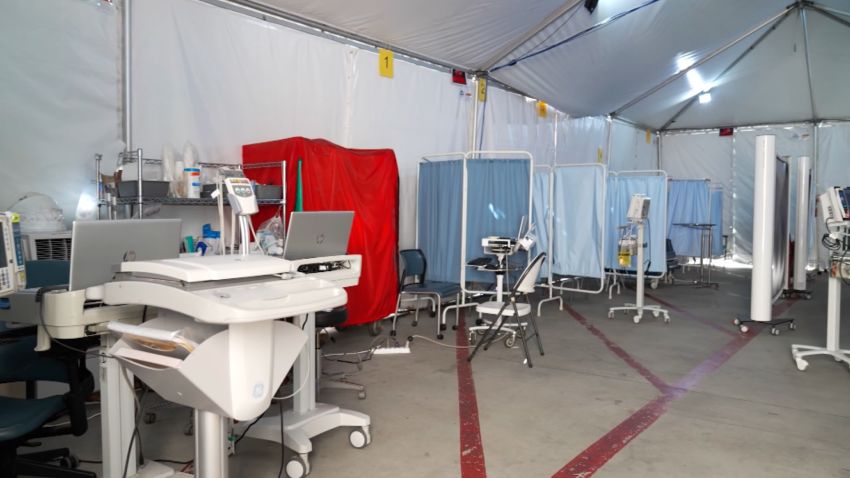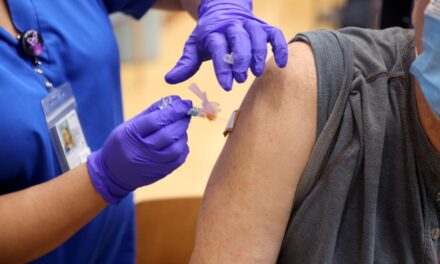
Amid brutal season of viral infections, children’s hospitals brace for impact of holiday gatherings

– Source: CNN ” data-uri=”archive.cms.cnn.com/_components/video-resource/instances/h_fe6f4c6feae7b521d09e3bf65d717000-h_e52fd5db6b2c0e04d882ce14b30328a8@published” data-video-id=”health/2022/12/13/trifecta-respiratory-viruses-covid-rsv-flu-hospitals-impact-elam-pkg-vpx.cnn” data-vr-video=””>


Hospitals are opening triages in parking lots amid ‘tripledemic’ surge
02:35 – Source: CNN
CNN —
Children’s hospitals are already full of sick kids and bracing for a potential increase in respiratory illnesses after holiday gatherings.
Any respite that hospital emergency rooms have gotten from falling RSV levels has vanished in the face of climbing flu case counts.
“Influenza activity is high and is driving a significant number of visits to our emergency department,” Children’s Hospital of Philadelphia spokesperson Ben Leach said. “We are seeing fewer hospitalizations related to the flu than we were related to RSV, but the rise in upper respiratory infections has led to increased wait times in emergency departments as well as our urgent care and primary care settings.”
For the past few months, pediatric hospital beds have consistently been about three-quarters full, federal data shows – straining capacity even more than average for the past few years of the Covid-19 pandemic.
The hospital units are nearly full on most days at Children’s Hospital Colorado, according to Associate Chief Medical Officer Dr. Kevin Carney.
“While we certainly hope families and friends have an opportunity to gather and spend time together this holiday season, this is also a time where we often see spikes in viral infections. There is still plenty of RSV, COVID and influenza circulating and we encourage everyone to take precautions to keep themselves, their children and others healthy,” he said in a statement.
Across the country, flu activity remains high, and RSV hospitalizations are still higher than normal.
But there are some potential signs of relief. Flu hospitalizations improved last week, after the worst week of the season that hit post-Thanksgiving, and RSV has peaked in the US as test positivity rates and new hospitalization rates have slowed over the past month.
The Colorado Hospital Association said it is deactivating the Combined Hospital Transfer Center, a program that enabled overwhelmed pediatric hospitals to transfer young patients with Covid-19, RSV or flu to other hospitals, because cases have plateaued.
“Colorado hospitals are prepared to employ our capacity management tools, including the CHTC, if we face another surge,” Jeff Tieman, the Colorado Hospital Association president and CEO, said in a statement.
In California, UC Davis Health spokesperson Edwin Garcia said that “overall numbers on viruses are high, but things are still manageable.”
Health care workers urge families to take precautions – like wearing masks in crowded indoor settings, washing their hands frequently and getting their flu vaccine and Covid-19 booster shots if they haven’t already – to prevent an influx of flu and Covid-19 cases over the next few weeks.
“Sometimes, holidays do lead to sometimes a small, sometimes a modest spike in infections, with people gathering together indoors,” Dr. Sean O’Leary, chair of the American Academy of Pediatrics’ Committee on Infectious Diseases and professor of pediatric infectious disease at the University of Colorado School of Medicine and Children’s Hospital Colorado.
But with RSV and flu circulating at high levels early in the season and well before the holidays, he said, “it’s a bit hard to predict what’s going to happen now that both of these may have peaked already.”
There’s some concern too that viral infections like the flu can leave the body more vulnerable to secondary bacterial infections.
O’Leary said he started noticing an increase in invasive group A strep infections in November. The US Centers for Disease Control and Prevention has said it’s investigating an apparent increase in the infections too, but the rise may indicate a return to pre-pandemic levels, or it might reflect the high numbers of viral respiratory infections already this season.
“You can get an invasive group A strep infection without having an underlying viral infection, but often they also happen as a complication of a viral infection,” O’Leary said.
Strep A, or group A streptococcus, is a bacteria found in the throat and on the skin that usually causes fever and throat infections, such as strep throat or scarlet fever. Invasive group A strep infections are more rare and serious; they include necrotizing fasciitis and streptococcal toxic shock syndrome, which can be deadly.
Strep A is not fatal for most people who become infected, and antibiotics are usually effective at treating them.
High demand for over-the-counter children’s medicine and antibiotics is posing a challenge for families and health care workers alike.
“Certainly, when you see a lot more sick kids, you’re going to see a lot more use of those medicines,” O’Leary said.
Sales of pediatric pain relievers are up 65% from this time last year, according to the Consumer Healthcare Products Association.
The demand has led pharmacies like CVS and Walgreens to limit purchases of children’s pain relief products.
The increase in illnesses, the shortage of medications, the hospitals teetering at the edge of capacity – all of this tells O’Leary that public health needs to be bolstered with more investment.
“In a lot of ways, we aren’t prepared for big epidemics and pandemics because of the way our health system operates. And so that’s what we saw during the [Covid-19] pandemic. And further investment, of course, in public health is always something that’s a good idea, and we see that with emergencies, like the pandemic, but as you’ve probably seen, as the emergency abates, that funding dries up pretty quickly, and then we wait till the next time that something happens,” he said.
For now, it’s all hands on deck for health care providers trying to get through a brutal respiratory virus season.
“A lot of people are moonlighting where they otherwise wouldn’t, and that includes all staff and clinic physicians as well,” O’Leary said. “So people are really stepping up to the plate to meet the need right now, but yeah, we could certainly use a breather.”
Source: https://www.cnn.com/2022/12/21/health/childrens-hospitals-respiratory-illnesses-holiday/index.html


















